Abstract
We have studied the shape of rabbit Immunoglobulin G molecules in solution by using singlet-singlet energy transfer to determine the minimum distance between the two hapten binding sites. A hybrid antibody was prepared in which one site specifically bound the energy donor, ε-dansyl-lysine, and the other site bound the energy acceptor, fluorescein. For this donor-acceptor pair, R0 was calculated to be 4.8 ± 0.2 nm (48 ± 2 Å). From a comparison of the lifetime of the donor's excited state in the presence or absence of acceptor, it was found that no energy transfer had occurred in the hybrid. Since the maximum distance over which transfer is measurable was 8.2 nm (82 Å; 1.7 R0), and since the Fab moieties exhibit segmental flexibility, the average distance between the two hapten-binding sites was estimated to be 9.2-10 nm (92-102 Å). If one assumes that the length of the Fab fragment is 7 nm (70 Å), the corresponding minimum angle between Fab moieties, αM, would be 80-95°. The molecules in solution, thus, have an open Y- or T-shaped configuration in which the hapten binding sites are not more than 2.5 nm (25 Å) from the extreme ends of the Fab fragments. The existence of conformations in which αM is less than 80°, as has been observed in some antibody-antigen complexes, must therefore be the result of definite conformational changes.
Keywords: rabbit antiserum, hapten, fluorescein, singlet-singlet energy transfer, conformation
Full text
PDF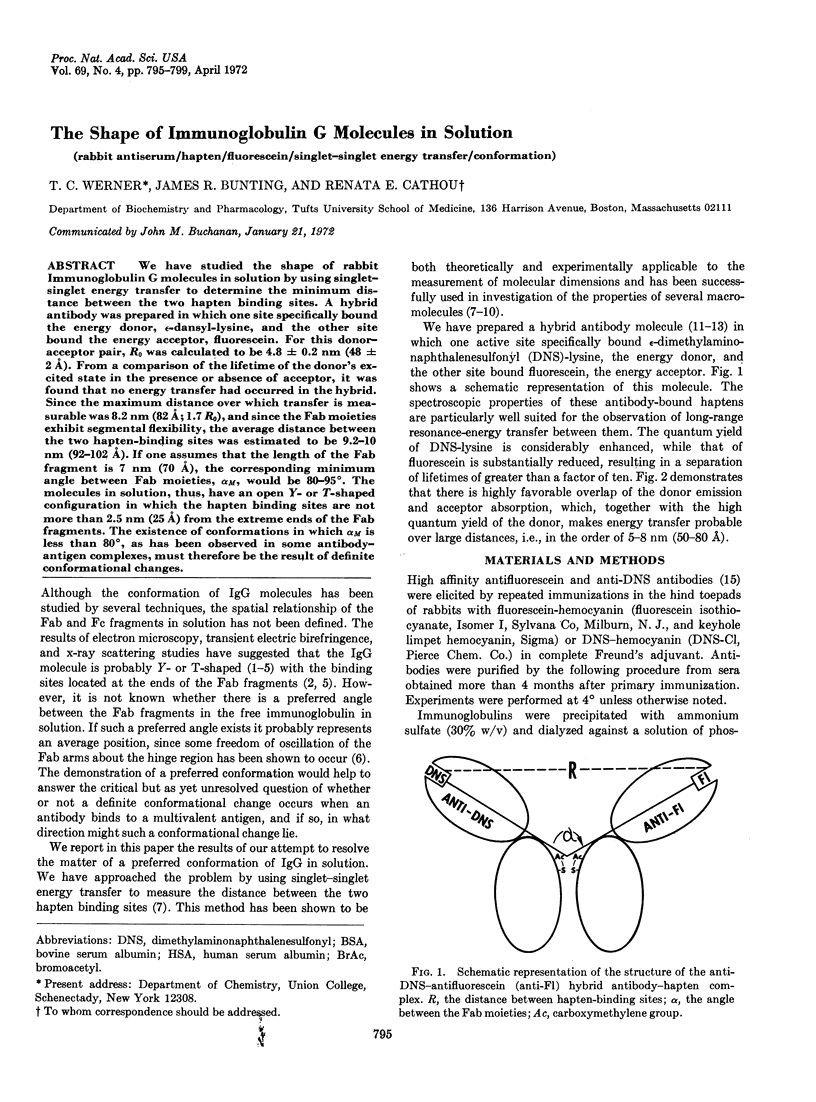
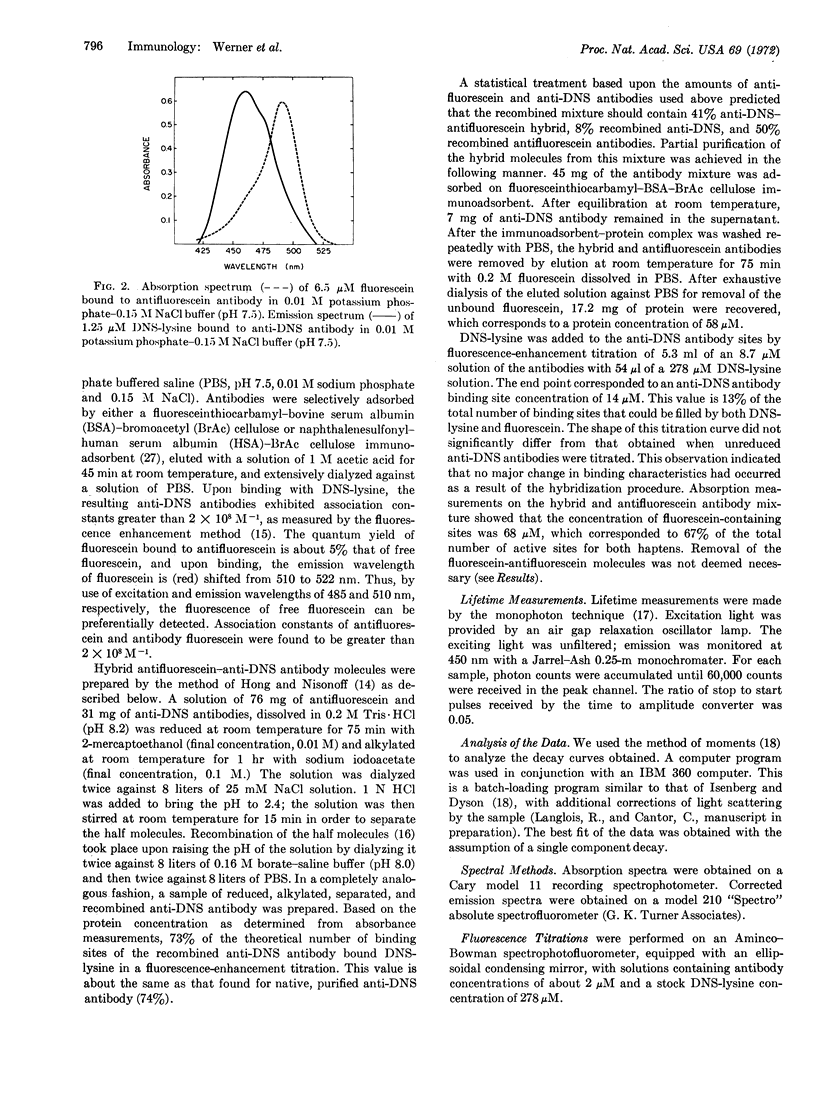
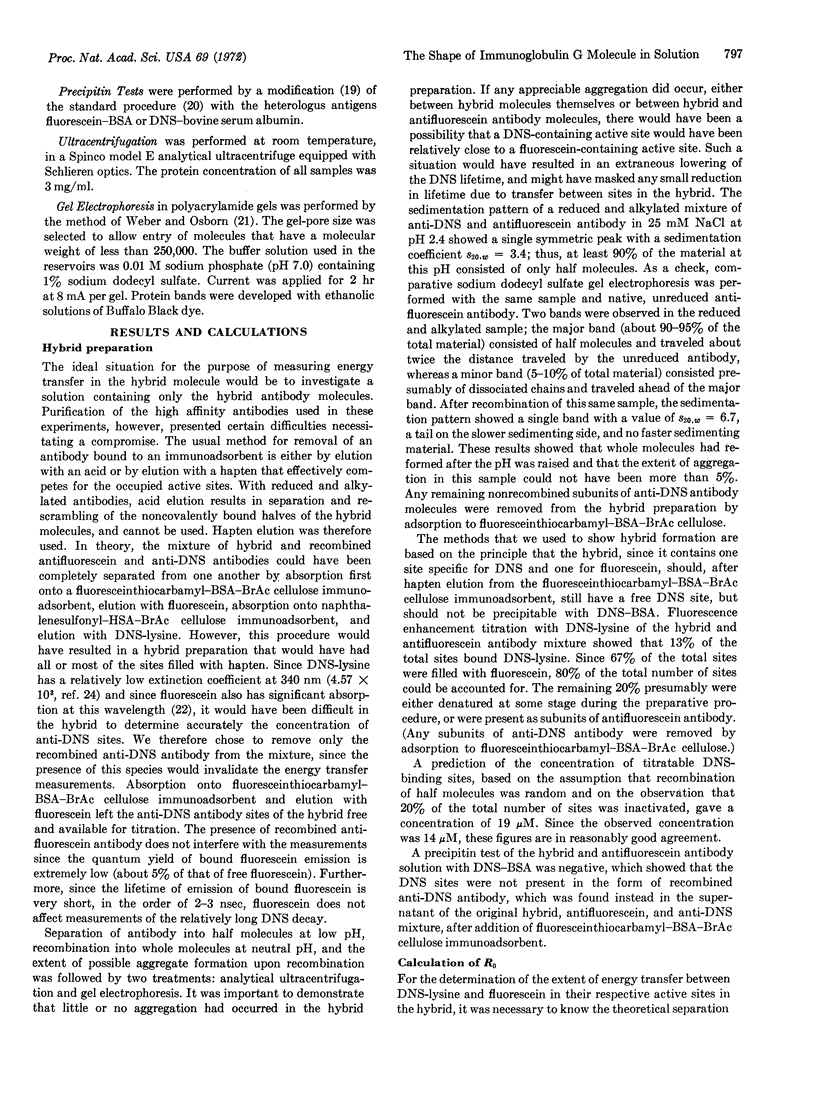
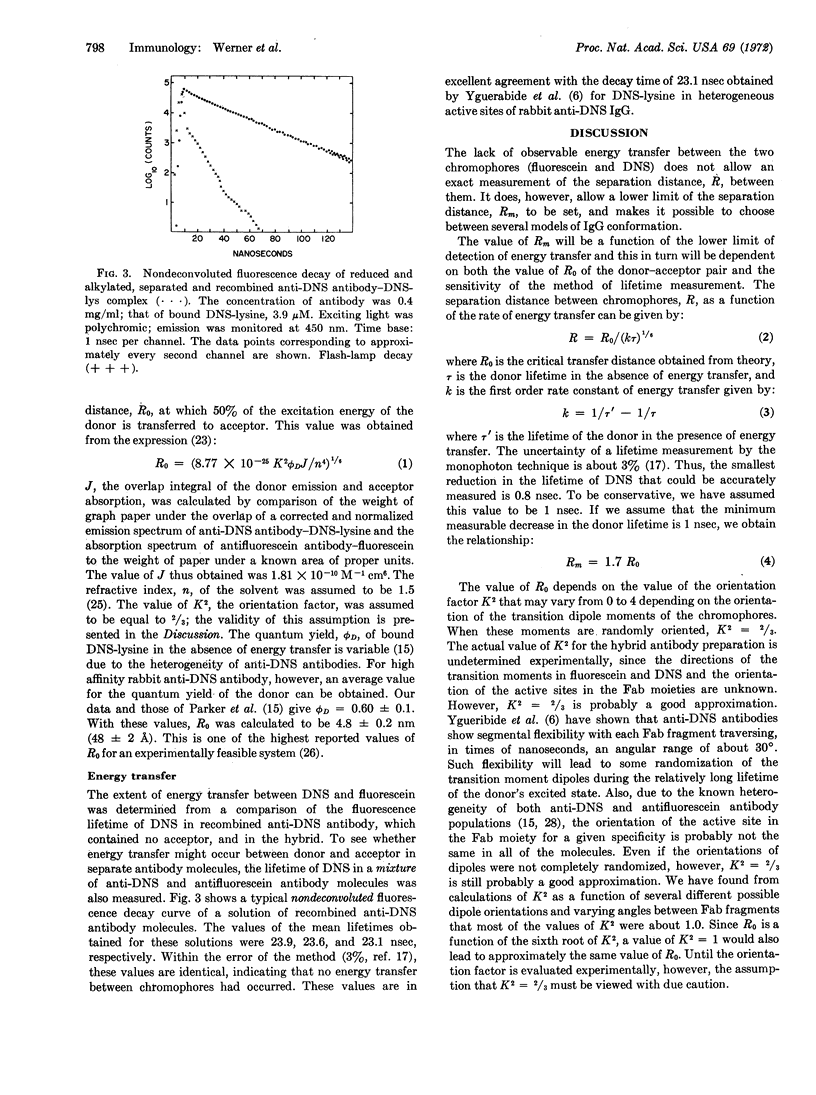
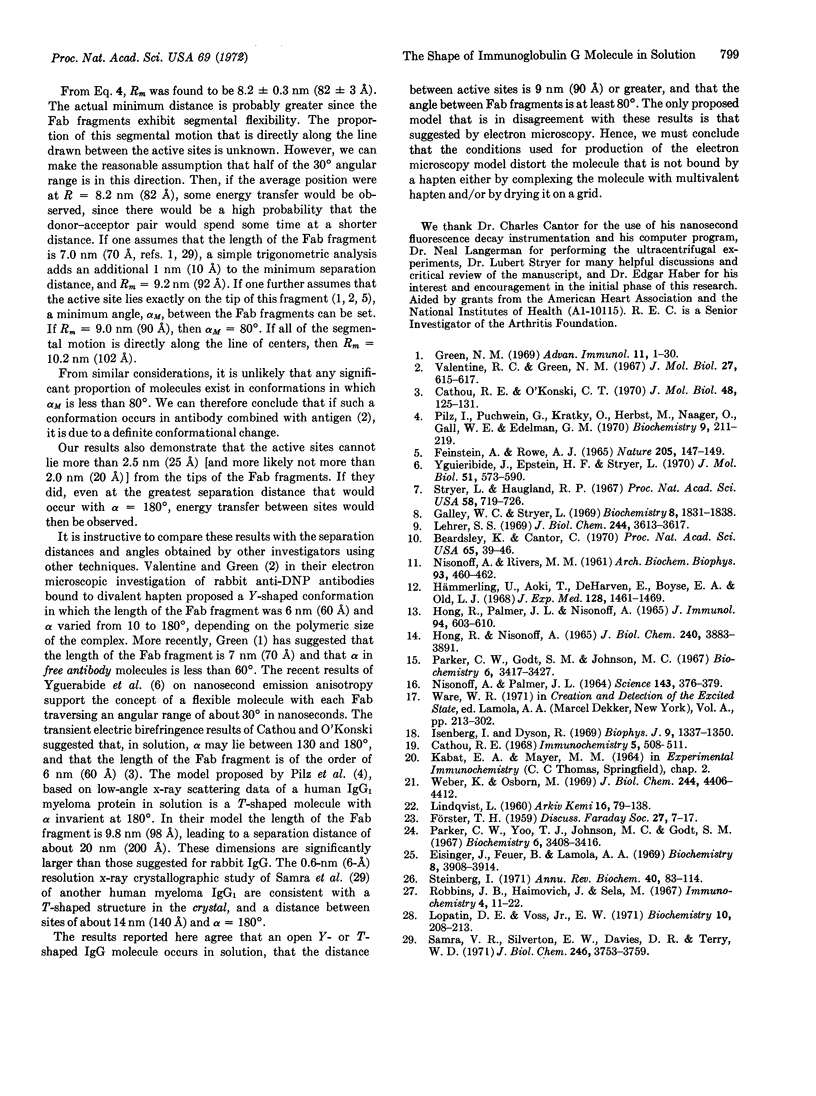
Selected References
These references are in PubMed. This may not be the complete list of references from this article.
- Beardsley K., Cantor C. R. Studies of transfer RNA tertiary structure by singlet-singlet energy transfer. Proc Natl Acad Sci U S A. 1970 Jan;65(1):39–46. doi: 10.1073/pnas.65.1.39. [DOI] [PMC free article] [PubMed] [Google Scholar]
- Cathou R. E., O'Konski C. T. A transient electric birefringence study of the structure of specific IgG antibody. J Mol Biol. 1970 Feb 28;48(1):125–131. doi: 10.1016/0022-2836(70)90223-8. [DOI] [PubMed] [Google Scholar]
- Eisinger J., Feuer B., Lamola A. A. Intramolecular singlet excitation transfer. Applications to polypeptides. Biochemistry. 1969 Oct;8(10):3908–3915. doi: 10.1021/bi00838a005. [DOI] [PubMed] [Google Scholar]
- FEINSTEIN A., ROWE A. J. MOLECULAR MECHANISM OF FORMATION OF AN ANTIGEN-ANTIBODY COMPLEX. Nature. 1965 Jan 9;205:147–149. doi: 10.1038/205147a0. [DOI] [PubMed] [Google Scholar]
- Galley W. C., Stryer L. Triplet-singlet energy transfer in proteins. Biochemistry. 1969 May;8(5):1831–1838. doi: 10.1021/bi00833a008. [DOI] [PubMed] [Google Scholar]
- Green N. M. Electron microscopy of the immunoglobulins. Adv Immunol. 1969;11:1–30. doi: 10.1016/s0065-2776(08)60476-9. [DOI] [PubMed] [Google Scholar]
- HONG R., PALMER J. L., NISONOFF A. UNIVALENCE OF HALF-MOLECULES OF RABBIT ANTIBODY. J Immunol. 1965 Apr;94:603–610. [PubMed] [Google Scholar]
- Hong R., Nisonoff A. Relative labilities of the two types of interchain disulfide bond of rabbit gamma G-immunoglobulin. J Biol Chem. 1965 Oct;240(10):3883–3891. [PubMed] [Google Scholar]
- Hämmerling U., Aoki T., de Harven E., Boyse E. A., Old L. J. Use of hybrid antibody with anti-gamma-G and anti-ferritin specificities in locating cell surface antigens by electron microscopy. J Exp Med. 1968 Dec 1;128(6):1461–1473. doi: 10.1084/jem.128.6.1461. [DOI] [PMC free article] [PubMed] [Google Scholar]
- Isenberg I., Dyson R. D. The analysis of fluorescence decay by a method of moments. Biophys J. 1969 Nov;9(11):1337–1350. doi: 10.1016/S0006-3495(69)86456-8. [DOI] [PMC free article] [PubMed] [Google Scholar]
- Lehrer S. S. Fluorescence and absorption studies of the binding of copper and iron to transferrin. J Biol Chem. 1969 Jul 10;244(13):3613–3617. [PubMed] [Google Scholar]
- Lopatin D. E., Voss E. W., Jr Fluorescein. Hapten and antibody active-site probe. Biochemistry. 1971 Jan 19;10(2):208–213. doi: 10.1021/bi00778a003. [DOI] [PubMed] [Google Scholar]
- NISONOFF A., PALMER J. L. HYBRIDIZATION OF HALF MOLECULES OF RABBIT GAMMA GLOBULIN. Science. 1964 Jan 24;143(3604):376–379. doi: 10.1126/science.143.3604.376. [DOI] [PubMed] [Google Scholar]
- NISONOFF A., RIVERS M. M. Recombination of a mixture of univalent antibody fragments of different specificity. Arch Biochem Biophys. 1961 May;93:460–462. doi: 10.1016/0003-9861(61)90296-x. [DOI] [PubMed] [Google Scholar]
- Parker C. W., Godt S. M., Johnson M. C. Fluorescent probes for the study of the antibody-hapten reaction. II. Variation in te antibody combining site during the immune response. Biochemistry. 1967 Nov;6(11):3417–3427. doi: 10.1021/bi00863a012. [DOI] [PubMed] [Google Scholar]
- Parker C. W., Yoo T. J., Johnson M. C., Godt S. M. Fluorescent probes for the study of the antibody-hapten reaction. I. Binding of the 5-dimethylaminonaphthalene-1-sulfonamido group by homologous rabbit antibody. Biochemistry. 1967 Nov;6(11):3408–3416. doi: 10.1021/bi00863a011. [DOI] [PubMed] [Google Scholar]
- Pilz I., Puchwein G., Kratky O., Herbst M., Haager O., Gall W. E., Edelman G. M. Small angle x-ray scattering of a homogeneous gamm G-1 immunoglobulin. Biochemistry. 1970 Jan 20;9(2):211–219. doi: 10.1021/bi00804a004. [DOI] [PubMed] [Google Scholar]
- Robbins J. B., Haimovich J., Sela M. Purification of antibodies with immunoadsorbents prepared using bromoacetyl cellulose. Immunochemistry. 1967 Jan;4(1):11–22. doi: 10.1016/0019-2791(67)90192-9. [DOI] [PubMed] [Google Scholar]
- Sarma V. R., Silverton E. W., Davies D. R., Terry W. D. The three-dimensional structure at 6 A resolution of a human gamma Gl immunoglobulin molecule. J Biol Chem. 1971 Jun 10;246(11):3753–3759. [PubMed] [Google Scholar]
- Steinberg I. Z. Long-range nonradiative transfer of electronic excitation energy in proteins and polypeptides. Annu Rev Biochem. 1971;40:83–114. doi: 10.1146/annurev.bi.40.070171.000503. [DOI] [PubMed] [Google Scholar]
- Stryer L., Haugland R. P. Energy transfer: a spectroscopic ruler. Proc Natl Acad Sci U S A. 1967 Aug;58(2):719–726. doi: 10.1073/pnas.58.2.719. [DOI] [PMC free article] [PubMed] [Google Scholar]
- Valentine R. C., Green N. M. Electron microscopy of an antibody-hapten complex. J Mol Biol. 1967 Aug 14;27(3):615–617. doi: 10.1016/0022-2836(67)90063-0. [DOI] [PubMed] [Google Scholar]
- Weber K., Osborn M. The reliability of molecular weight determinations by dodecyl sulfate-polyacrylamide gel electrophoresis. J Biol Chem. 1969 Aug 25;244(16):4406–4412. [PubMed] [Google Scholar]
- Yguerabide J., Epstein H. F., Stryer L. Segmental flexibility in an antibody molecule. J Mol Biol. 1970 Aug;51(3):573–590. doi: 10.1016/0022-2836(70)90009-4. [DOI] [PubMed] [Google Scholar]


